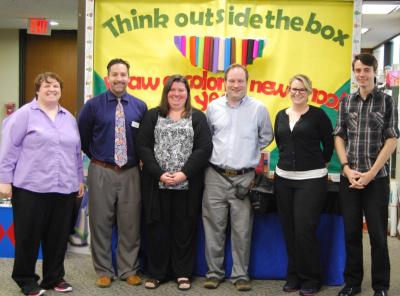Tuscaloosa (Ala.) Public Library is one of 10 public libraries that comprise the Libraries Transforming Communities Public Innovators Cohort. Here, Library Associate Larry Boothe (shown below, at right) shares his tips for getting acquainted with the "turning outward" approach.
Our library system became part of the Libraries Transforming Communities (LTC) Public Innovators Cohort last year and began taking part in an intensive, 18-month training in the Harwood Institute’s “turning outward” approach. But after several months of prep-work and several more using the Harwood tools, my library had some staff turnover that led to replacing nearly our entire LTC team.

As a result, I was asked to take the place of our last facilitator and conversation leader, which gave me some pretty big shoes to fill. By that point, we had started hosting community conversations to learn about our patrons’ thoughts on public safety, and with little notice, I had to step up to the plate and lead those conversations.
I did have a little trouble getting started; the words used by the Harwood Institute (like "aspirations" and "intentionality") were somewhat confusing at first. But once I locked down what their tools and practices meant, the learning process became much smoother. Below are some lessons I learned from my “fast-tracked” learning process.
1. Read the materials (preferably with your team). If someone were to stumble onto the “turning outward” approach, tools or website, the first thing that individual (or library) should look for is the “Step-by-Step Guide to Getting Started in Your Community” and the Resources for Libraries webpage. The workbook and resource page offer a lot of valuable information about ALA, Harwood and LTC.
However, because it is a lot of information, it can feel overwhelming to take it all in at once. What helped me and some of the new members of our team was holding a few LTC meetings specifically to go over the tools and practices. As a team, we started from the beginning of the approach, learning what all the tools meant, what they were used for, and how the old team used them. The most useful advice I can give for newcomers is simply to not rush through the information. Take time to understand each tool before trying to start, and definitely go in order.
2. Watch the webinars. Newcomers should also take a look at all of the archived webinars on the LTC Resources for Libraries webpage as they go along. (These webinars were recorded for the LTC Public Innovators Cohort over the past year.) Having a visual aspect and also a coach talking about the tools helps a lot more than studying the materials alone.
3. Talk to the “experts.” What helped me the most in the early weeks of using the “turning outward” approach was the support of the facilitator whose place I was taking. I was able to sit down with him and he gave me all of the materials, tools, handouts and work that had been done so far and explained every step. He also explained what my responsibilities would be as a facilitator and conversation leader and some personal tips for dealing with the community during community conversations. Ultimately, the new members worked with several “old” members to hold a practice community conversation on the staff to ensure that the new members understood their part in one of the vital areas of the approach. If you don’t know anyone who is experienced in the Harwood approach it may help to join ALA’s Libraries Foster Community Engagement Connect group and pose questions there, or read the LTC blog to get advice.
Once you feel comfortable with the practice, tools and exercises, the Harwood approach can help you and/or your team to turn outward and more effectively engage with the community.


